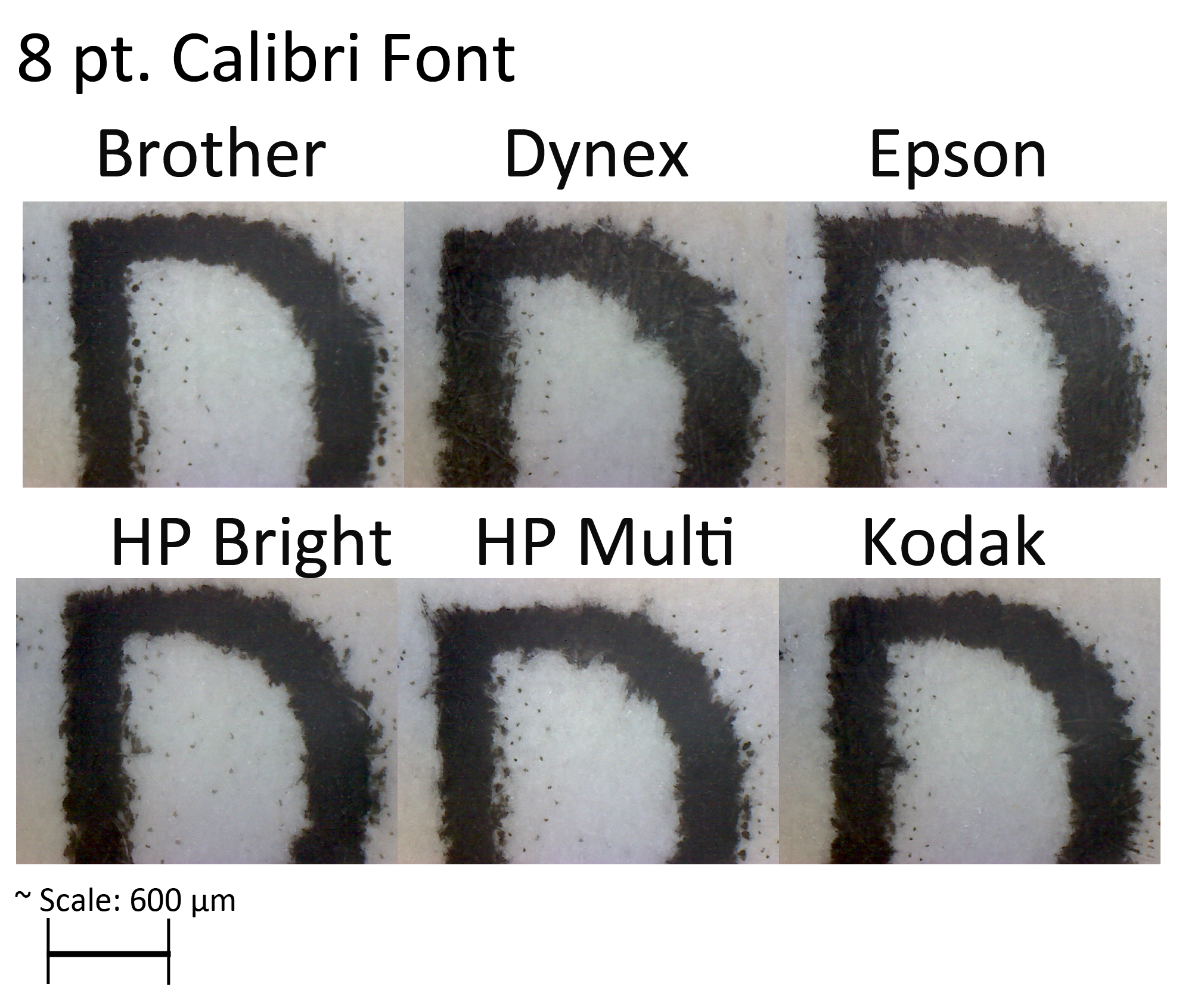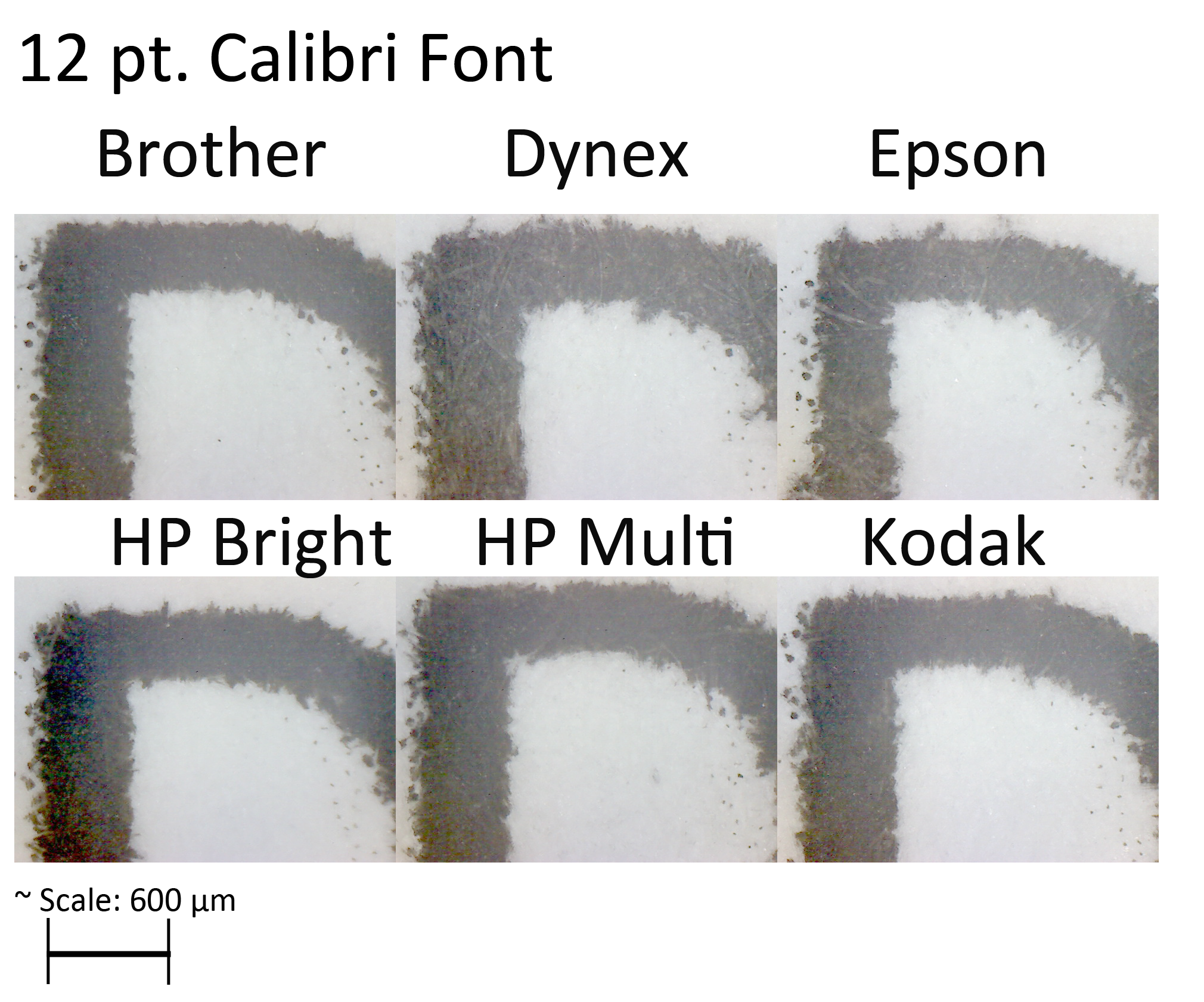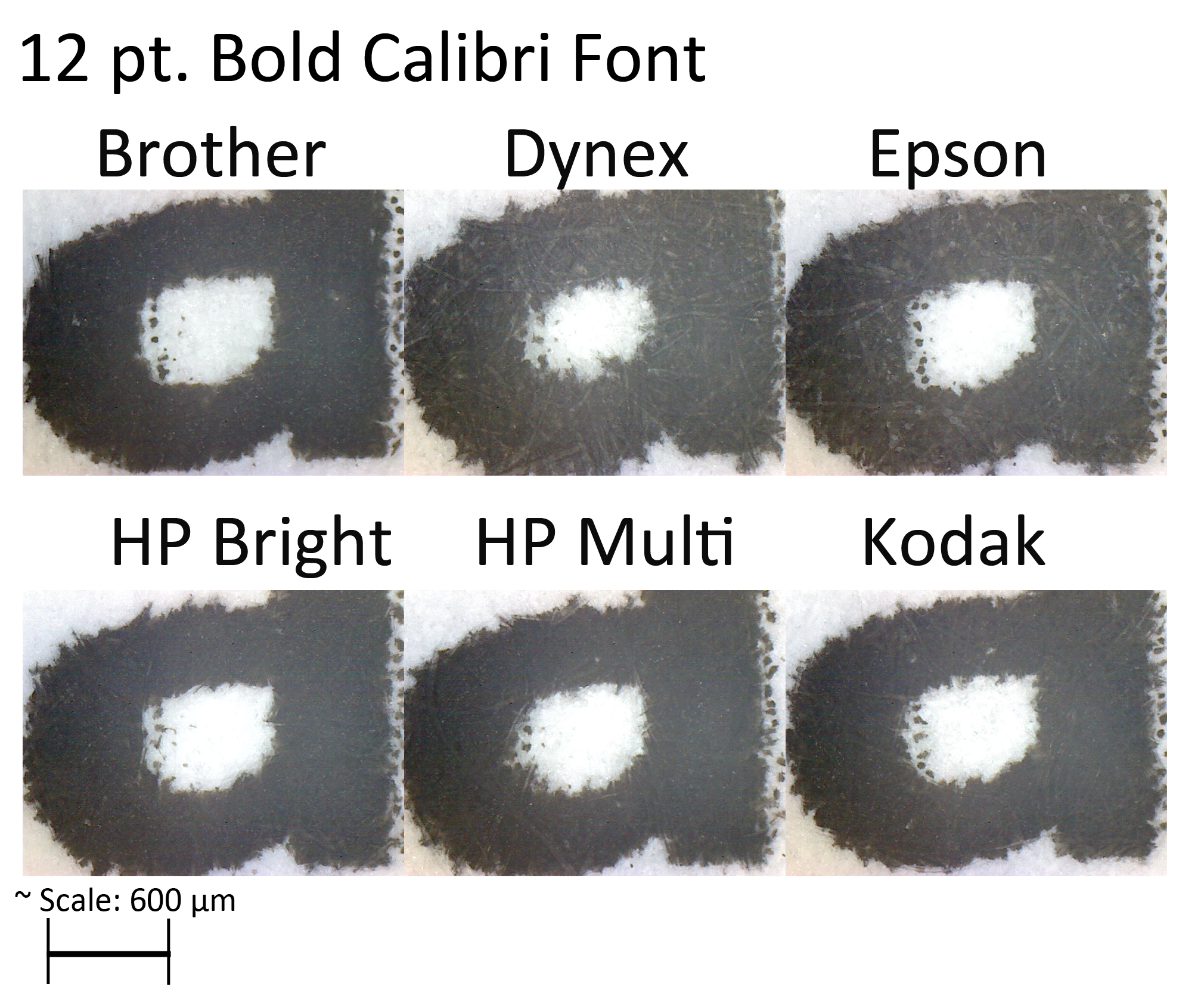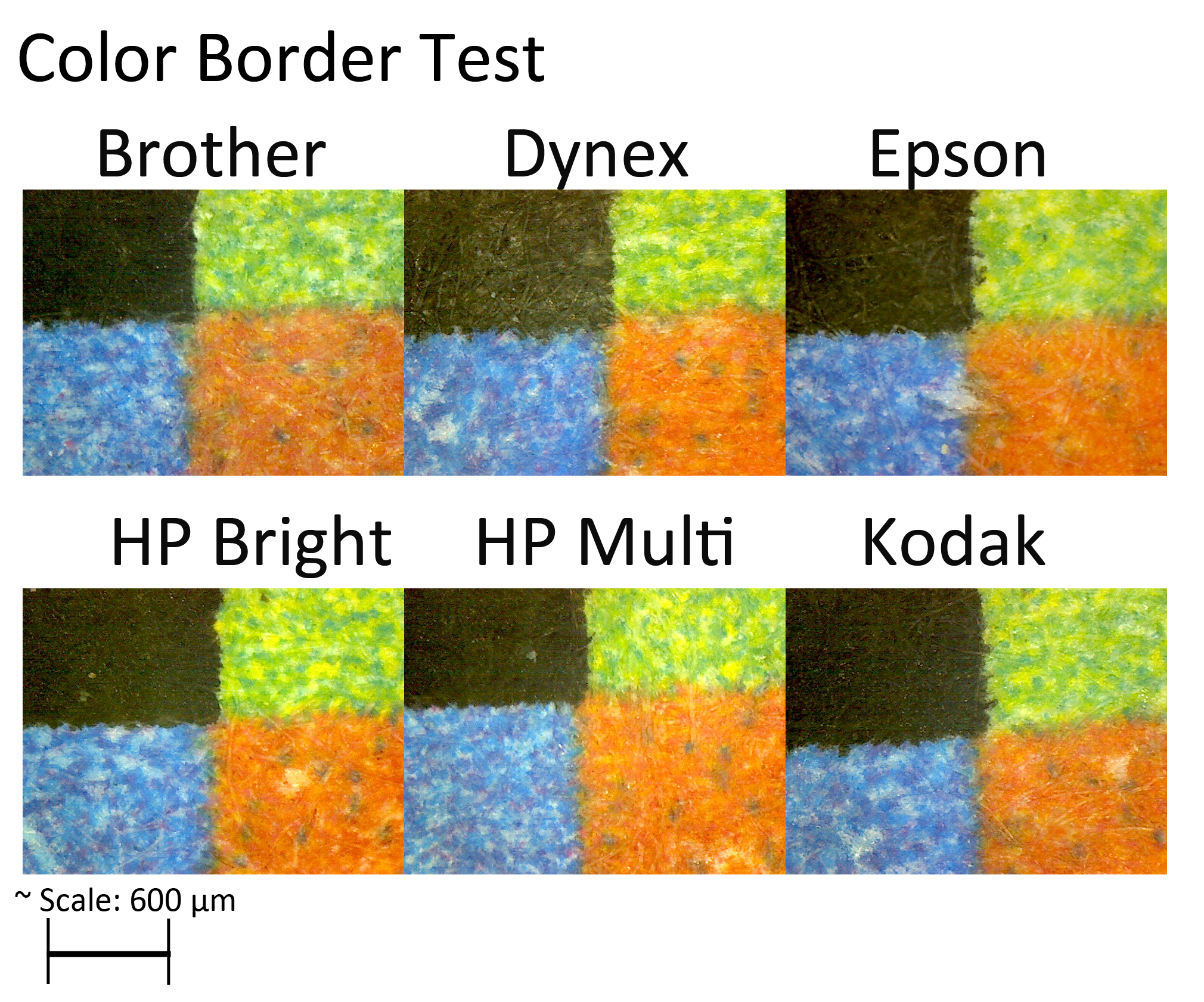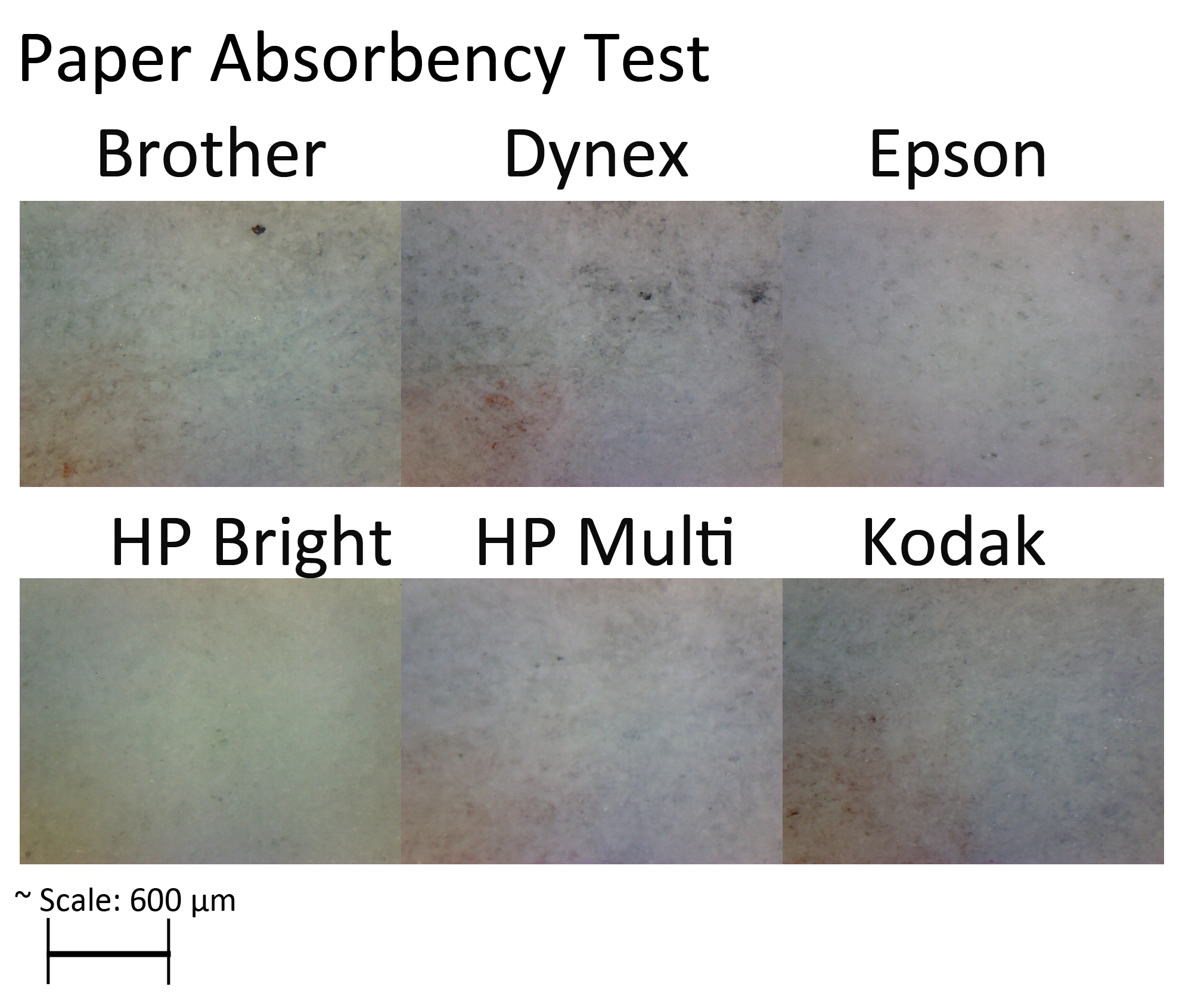Tom's Hardware Benchmarks Inkjet Printer Paper!
Standard Print Quality: Absorbency And Text Performance
Color reproduction is only one aspect of paper performance. The other major aspect is absorbency. The production of paper involves forming a fiber mat on a mesh screen and pressing it flat. High-quality inkjet paper must balance ink absorbency with a tendency to spread sideways. The easiest way to solve this problem is by producing very fine paper fibers. As the size of the fiber decreases, fewer fibers extend through the mat. This is why the text on one brand of paper can appear crisper than the text on another. Obviously, this is subjective, but we're using a high-powered microscope to show visual differences.
If you tend to print small fonts, you'll notice that each paper produces its own unique result. Brother's Multipurpose tends to produce fuzzy text because the paper is slightly more porous. Dynex and Epson seem to produce poor text because the first layer of fibers doesn't adequately absorb the ink pigments. Kodak shows a similar effect, but it's not as severe. HP's Multipurpose produces the crispest text, but ink still slightly seeps out from the font's edge.
Brother continues to produce fuzzy but uniform text, which is a result that Kodak closely mimics. HP's Multipurpose produces crisp text, but there are non-uniform aberrations throughout the letter.
When it comes to borders, HP's Bright White and Multipurpose produce the least color bleed between neighboring color patches. Notice that there is a slight tear in our Epson printing sample. This anomaly will occasionally turn up with paper. Sometimes paper arrives in the ream this way; sometimes it's the fault of the printer.
Duplex printing is an easy way to reduce paper consumption, but, if your paper tends to let ink bleed through a lot, printing on both sides of a page yields poor results. Ink soaks through the paper and over-saturation causes the paper to curl or buckle. When we examine the opposite side of our color border test, we notice that Brother, Dynex, and Kodak all tend to let ink bleed through to the other side. The Bright White paper from Epson and HP yield the least bleed-through, but recall that these have a heavier weight (more paper fibers). In comparison, HP's Multipurpose is only 20 lb. paper, but there is little ink penetration.
Current page: Standard Print Quality: Absorbency And Text Performance
Prev Page High Print Quality: Color Gamut Next Page Final WordsGet Tom's Hardware's best news and in-depth reviews, straight to your inbox.
-
iam2thecrowe I was kind of in disbelief when I read this article. Its a good try....but far from what is seen in the real world. Speaking from a printer tech's point of view, I can tell you that using the wrong kind of paper in certain printers can give disasterous results. The ink can sit on top, smudge, bleed etc. The manufacturer designs consumer printers with presets for different paper types. The specific printer may put more or less ink, raise or lower the carriage depending on paper thickness, not to mention every manufacturer uses a different type of ink and will react differently with different paper. This article is leading people in the wrong direction. You will only get reliable results from your inkjet printer using the manufacturers correct spec paper and ink and correct settings in your printer driver. If you happen to find one that works well for you that is not stated in the manufacturers spec, then good for you, but don't complain if your prints come out like crap using the wrong paper.Reply -
acku Reply9514582 said:I was kind of in disbelief when I read this article. Its a good try....but far from what is seen in the real world. Speaking from a printer tech's point of view, I can tell you that using the wrong kind of paper in certain printers can give disasterous results. The ink can sit on top, smudge, bleed etc. The manufacturer designs consumer printers with presets for different paper types. The specific printer may put more or less ink, raise or lower the carriage depending on paper thickness, not to mention every manufacturer uses a different type of ink and will react differently with different paper. This article is leading people in the wrong direction. You will only get reliable results from your inkjet printer using the manufacturers correct spec paper and ink and correct settings in your printer driver. If you happen to find one that works well for you that is not stated in the manufacturers spec, then good for you, but don't complain if your prints come out like crap using the wrong paper.
That's very true when it comes to Photo Paper, but there are hundreds of attributes that matter. However, it is possible for brand B photo paper to be have more color gamut on brand A printer than brand A photo paper, if they're optimizing for color fastestness or water proofing.
This was a look at everyday paper where differences are negligible on between multiple brands. We got the same results on Epson, HP, Brother, and Kodak printers. We know there are and we have seen different results with Photo Paper. Such as Canon Photo Paper behaving differently on a Canon printer, Epson printer etc....
I have benchmarks from about 10 more printers of varying brands that line up with the results from the MG5220. For the sake of simplicity, we only presented one.
Cheers,
Andrew Ku
TomsHardware.com -
The prices of the HP Bright White and Multipurpose are switched between the first and last pages of this article. At first I thought that the Bright White was both the best of the bunch and one of the cheapest, which left me wondering if the ink fumes had made the reviewer a little woozy when I saw that the multipurpose got the recommendation.Reply
-
acku ReplyThe prices of the HP Bright White and Multipurpose are switched between the first and last pages of this article. At first I thought that the Bright White was both the best of the bunch and one of the cheapest, which left me wondering if the ink fumes had made the reviewer a little woozy when I saw that the multipurpose got the recommendation.
I think magic markers smell better. :kaola: Fixed! -
acku Reply9514586 said:Seriously? You are benchmarking PAPER? Does the word "obsessive" mean anything to you?
Maybe more neurotic than obsessive. -
iam2thecrowe ackuThat's very true when it comes to Photo Paper, but there are hundreds of attributes that matter. However, it is possible for brand B photo paper to be have more color gamut on brand A printer than brand A photo paper, if they're optimizing for color fastestness or water proofing. This was a look at everyday paper where differences are negligible on between multiple brands. We got the same results on Epson, HP, Brother, and Kodak printers. We know there are and we have seen different results with Photo Paper. Such as Canon Photo Paper behaving differently on a Canon printer, Epson printer etc....I have benchmarks from about 10 more printers of varying brands that line up with the results from the MG5220. For the sake of simplicity, we only presented one.Cheers,Andrew KuTomsHardware.comThanks for clarifying that. Just didnt want people to get the wrong idea.Reply -
nebun ackuMaybe more neurotic than obsessive.it is good....we need to know who manufacures the best paper if we want our prints to last us a lifetime :)Reply
